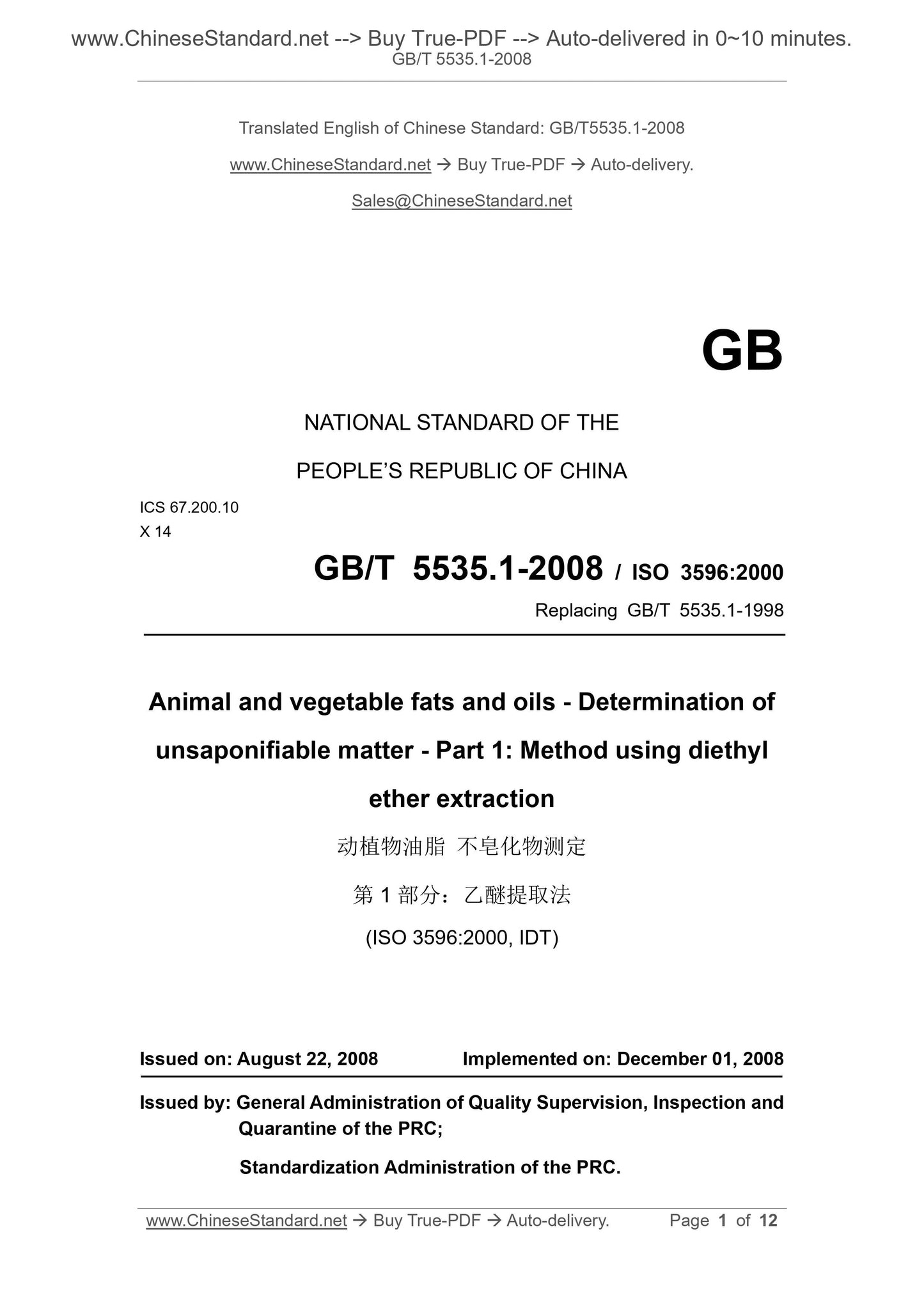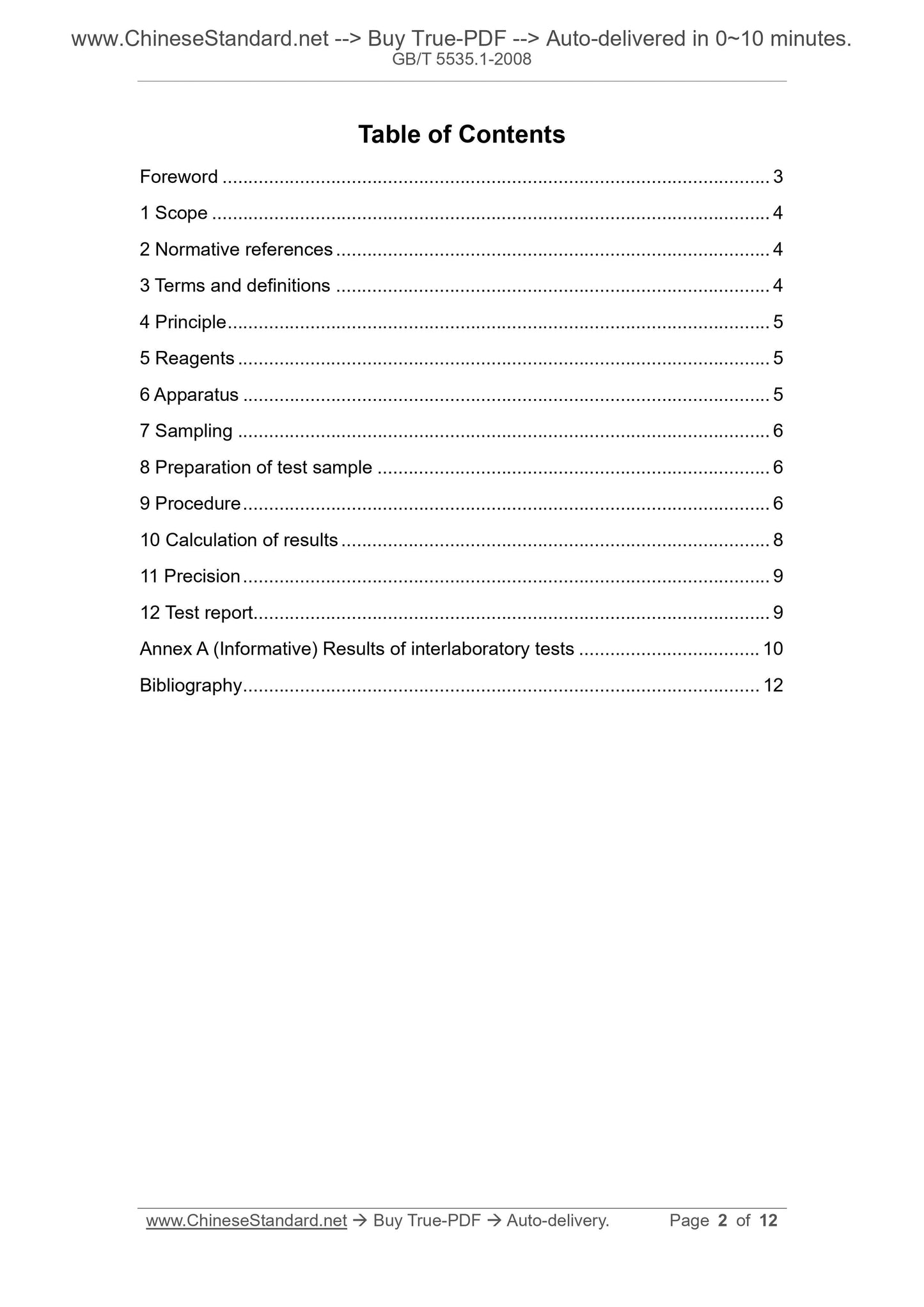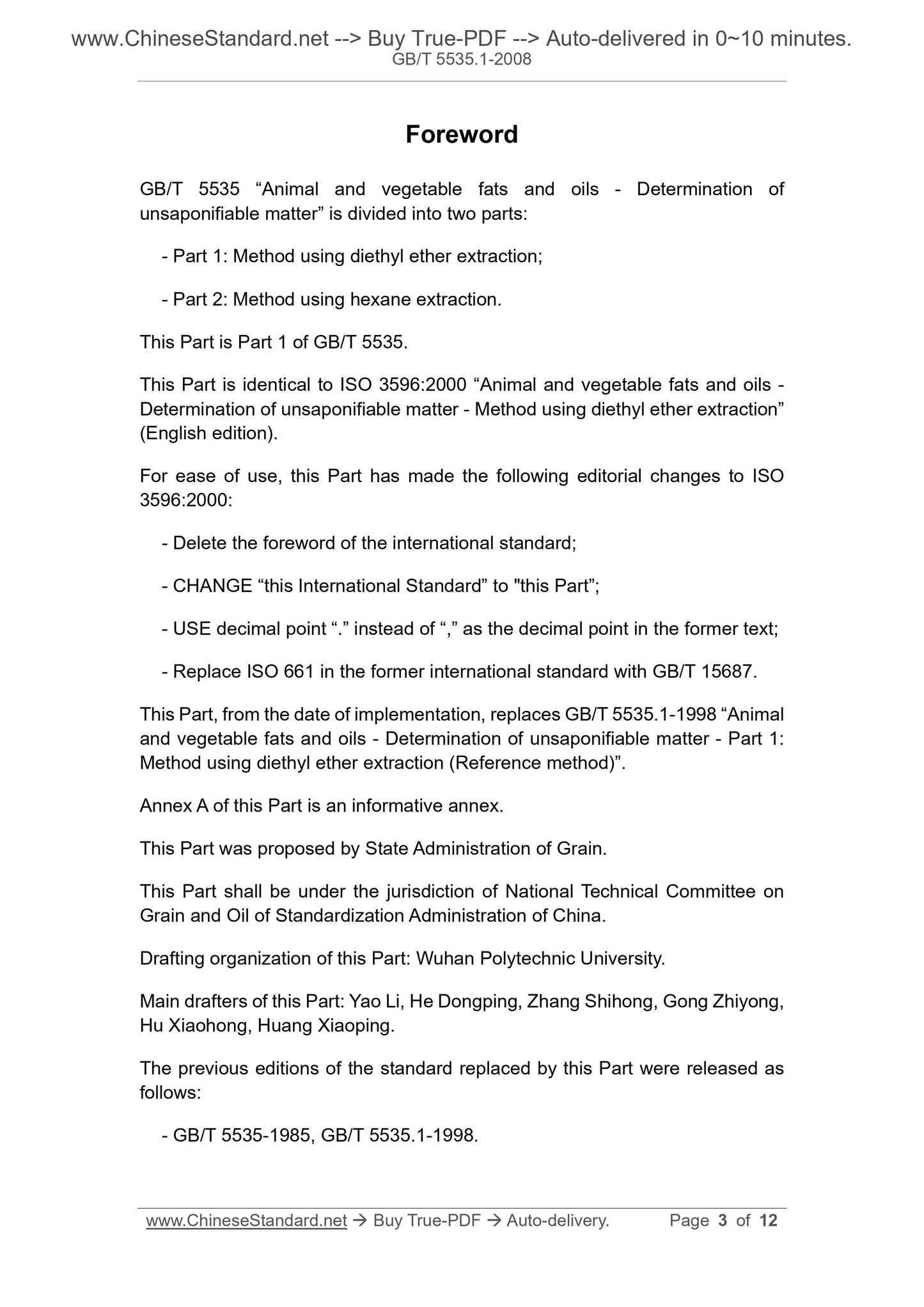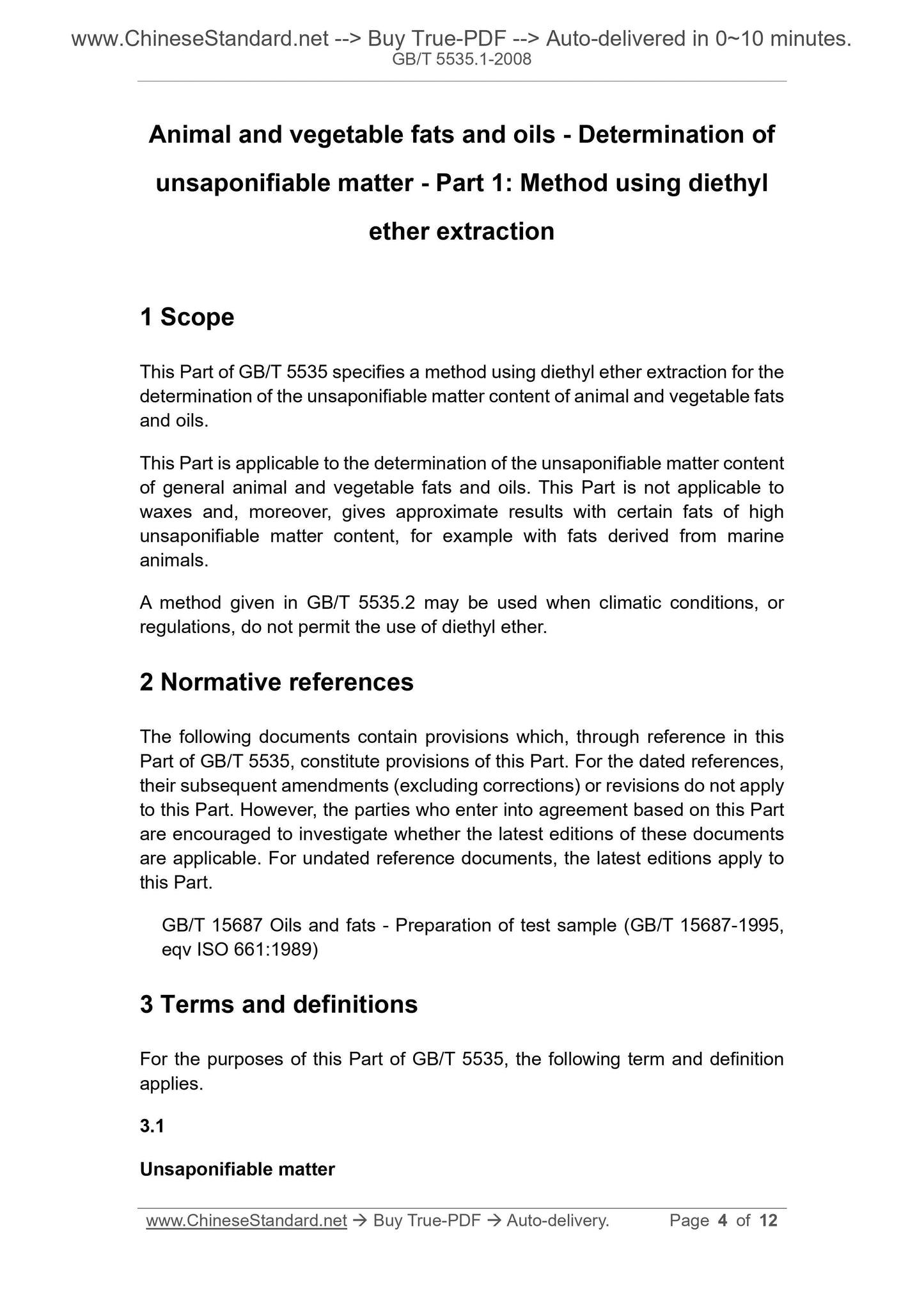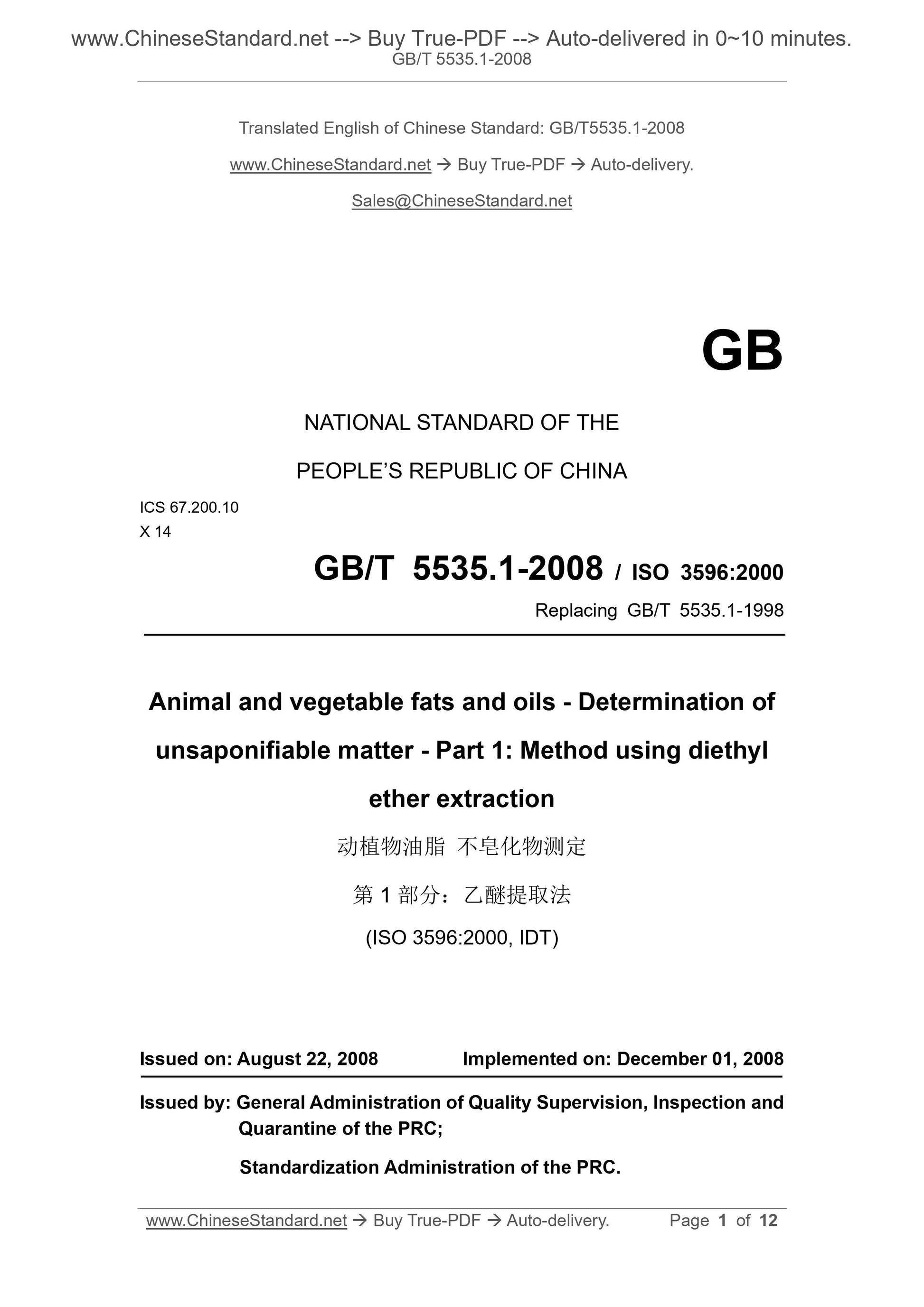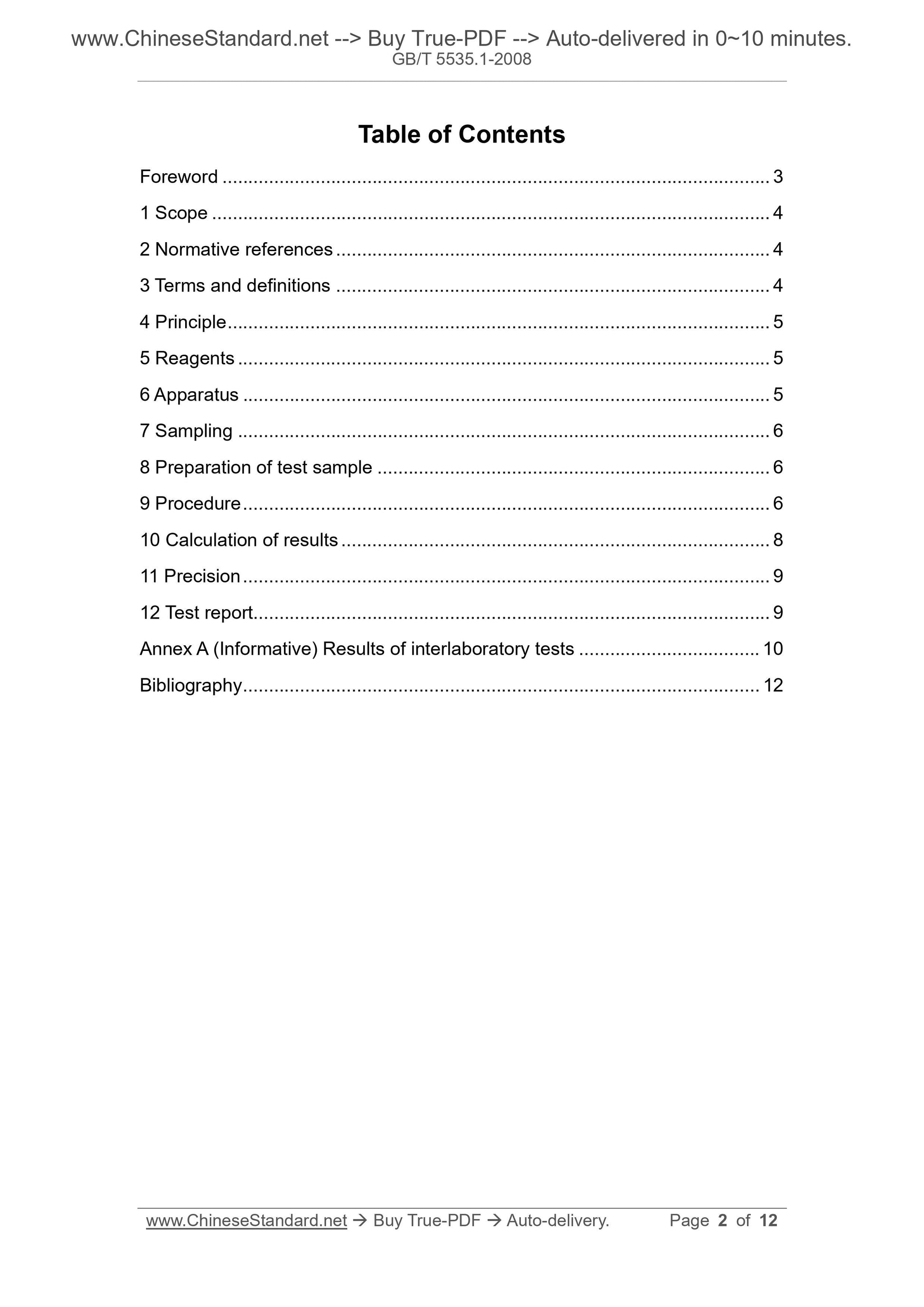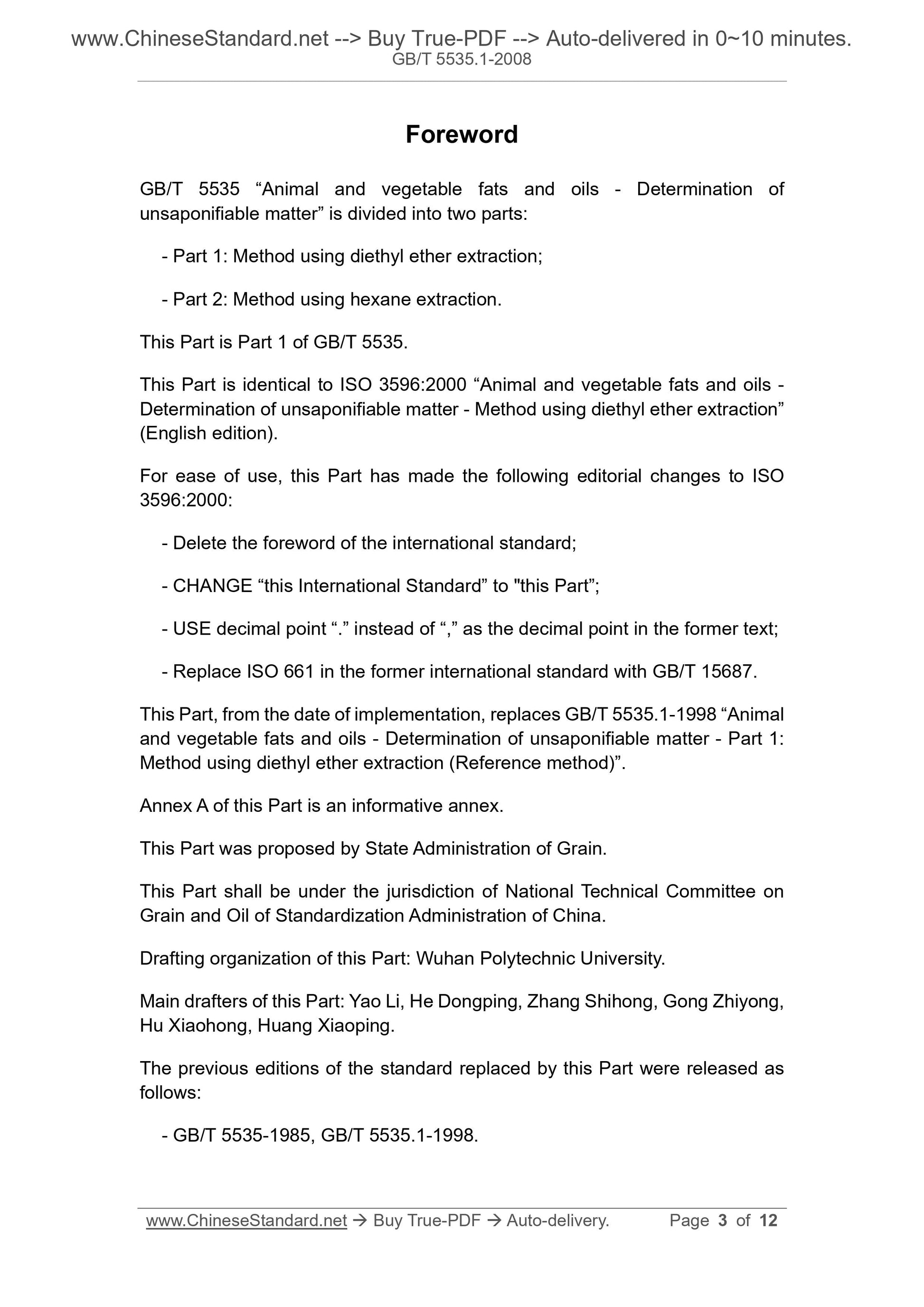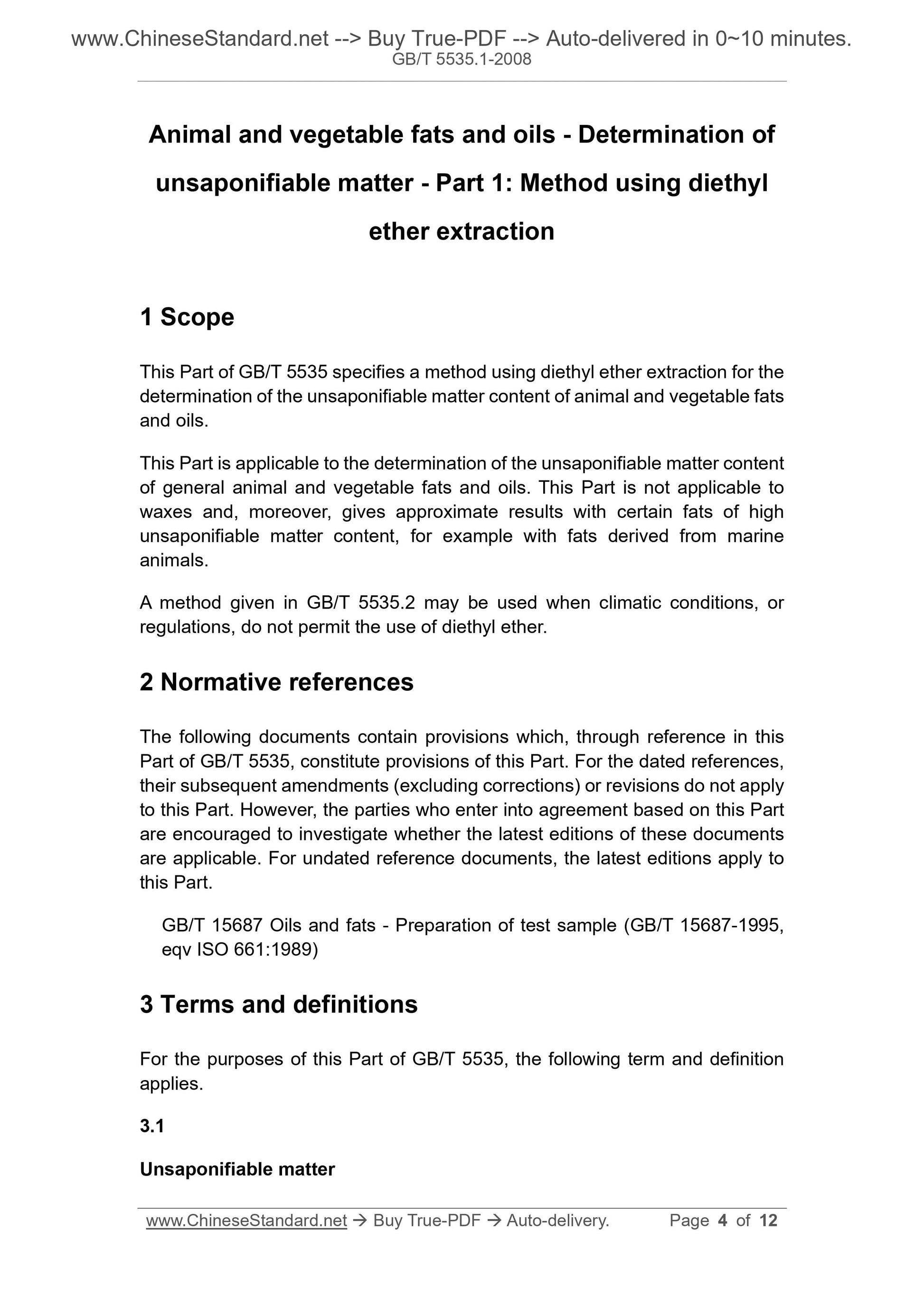1
/
of
4
PayPal, credit cards. Download editable-PDF and invoice in 1 second!
GB/T 5535.1-2008 English PDF (GB/T5535.1-2008)
GB/T 5535.1-2008 English PDF (GB/T5535.1-2008)
Regular price
$150.00 USD
Regular price
Sale price
$150.00 USD
Unit price
/
per
Shipping calculated at checkout.
Couldn't load pickup availability
Delivery: 3 seconds. Download true-PDF + Invoice.
Get QUOTATION in 1-minute: Click GB/T 5535.1-2008
Historical versions: GB/T 5535.1-2008
Preview True-PDF (Reload/Scroll if blank)
GB/T 5535.1-2008: Animal and vegetable fats and oils -- Determination of unsaponifiable matter -- Part 1: Method using diethyl ether extraction
GB/T 5535.1-2008
Animal and vegetable fats and oils.Determination of unsaponifiable matter.Part 1.Method using diethyl ether extraction
ICS 67.200.10
X14
National Standards of People's Republic of China
GB/T 553.5-1-2008/ISO 3596..2000
Replacing GB/T 553.5-1-1998
Determination of unsaponifiable matter of animal and vegetable fats
Part 1.Ether extraction method
(ISO 3596..2000, IDT)
2008-2008-22 released
2008-12 implementation
General Administration of Quality Supervision, Inspection and Quarantine of the People's Republic of China
Issued by China National Standardization Management Committee
Foreword
GB/T 5535 "Determination of Unsaponifiable Matter of Animals and Plants" is divided into two parts.
---Part 1.Ether extraction method;
---Part 2.Hexane extraction method.
This part is part 1 of GB/T 5535.
This part is equivalent to the use of ISO 3596.2000 "Determination of ether extraction of unsaponifiable matter of animal and vegetable oils and fats" (English version).
For ease of use, this section has made the following editorial changes to ISO 3596.2000.
--- Delete the preface of international standards;
--- Change "This International Standard" to "This Part";
---Replace the decimal point "." with the decimal point ".";
--- Use GB/T 15687 to replace ISO 661 in the original international standard.
This part replaces GB/T 553.5-1-1998 "Determination of unsaponifiable matter of animal and vegetable fats and oils, Part 1.Ether extraction"
Law (first method)".
Appendix A of this section is an informative appendix.
This part is proposed by the State Grain Administration.
This part is under the jurisdiction of the National Grain and Oil Standardization Technical Committee.
This section was drafted by. Wuhan Institute of Technology.
The main drafters of this section. Yao Li, He Dongping, Zhang Shihong, Gong Zhiyong, Hu Xiaohong, Huang Xiaoping.
The release of previous versions of the standard replaced by this part are.
---GB/T 5535-1985, GB/T 553.5-1-1998.
GB/T 553.5-1-2008/ISO 3596..2000
Determination of unsaponifiable matter of animal and vegetable fats
Part 1.Ether extraction method
1 Scope
This part of GB/T 5535 stipulates the method for the determination of the content of unsaponifiable matter of animal and vegetable oils and fats by the ether extraction method.
This section applies to the determination of unsaponifiable matter content of general animal and vegetable fats. This section does not apply to wax. For some unsaponifiable matter content
High fats, such as marine animal fats, can only get approximate results.
When climatic conditions or regulations do not allow the use of ether, the method of GB/T 553.2 can be used.
2 Normative references
The clauses in the following documents become the clauses of this part by quoting in this part of GB/T 5535.All quoted dates
The document, all subsequent amendments (not including errata content) or revisions are not applicable to this section, however, encourage
The parties to the agreement study whether the latest versions of these documents are available. For the cited documents without date, the latest version applies to this
section.
GB/T 15687 Preparation of grease samples (GB/T 15687-1995, eqv ISO 661.1989)
3 Terms and definitions
The following terms and definitions apply to this part of GB/T 5535.
3.1
All the products after saponification with potassium hydroxide are extracted with the specified solvent, and all the substances that are not volatile under the specified operating conditions.
4 Principle
The ethanol solution of fat and potassium hydroxide is saponified under boiling and refluxing conditions, the unsaponifiables are extracted from the saponified solution with ether, and the solvent is evaporated
Weigh the residue after drying.
5 Reagents
The reagents used in this section are analytically pure, and the water is distilled water, deionized water or water of equivalent purity.
5.1 Ether. Freshly steamed, free of peroxides and residues.
5.2 Acetone.
5.3 Potassium hydroxide-ethanol solution. Lu (KOH) ≈ 1mol/L. Dissolve 60g of potassium hydroxide in 50mL of water, then use 95% (volume
Fractions) Dilute with ethanol to 1000mL. The solution should be colorless or light yellow.
5.4 Potassium hydroxide aqueous solution. Lu (KOH) ≈0.5mol/L.
5.5 Phenolphthalein indicator solution. 95% (volume fraction) ethanol solution of 10g/L.
6 Instruments
Commonly used instruments in the laboratory, especially the following instruments.
6.1 Round-bottom flask. A 250mL round-bottom flask with a standard grind.
6.2 Reflux condenser. It has a grinding port matched with the flask (6.1).
GB/T 553.5-1-2008/ISO 3596..2000
6.3 500mL separating funnel. use Teflon stopcock and bottle stopper.
6.4 Water bath.
6.5 Electric oven. It can be controlled at 103℃±2℃.
7 skewer
Sampling is not the content specified in this part, it is recommended to use the ISO 5555 method.
The samples received by the laboratory should be representative and should not be damaged or changed during transportation and storage.
8 Sample preparation
According to GB/T 15687 implementation.
9 Operation steps
9.1 Sample
Weigh about 5g sample (Chapter 8), accurate to 0.01g, placed in a 250mL flask (6.1).
9.2 Saponification
Add 50mL of potassium hydroxide-ethanol solution (5.3) and some zeolite. After the flask is connected to the reflux condenser (6.2), carefully boil it back
Flow 1h. Stop heating, add 100mL of water from the top of the return tube and rotate and shake.
If the extracted unsaponifiable matter is used for the determination of tocopherol, it is necessary to add pyrogallol and complete the operation as soon as possible (within 30 min).
9.3 Extraction of unsaponifiables
After cooling, transfer the saponification liquid to a 500mL separatory funnel (6.3), wash the flask and zeolite several times with 100mL ether (5.1), and
Pour the lotion into the separatory funnel. Close the stopper, invert the separatory funnel, shake vigorously for 1 min, carefully open the stopcock, and release the internal pressure intermittently. Quiet
After layering, put the lower layer of saponification liquid as completely as possible into the second separating funnel. If an emulsion is formed, a small amount of ethanol or concentrated hydroxide can be added
Potassium or sodium chloride solutions are used for demulsification.
Using the same method, extract the saponification liquid twice with 100 mL of ether each time, collect the ether extract three times and put it in 40 mL of water
In the separatory funnel.
9.4 Washing of ether extract
Gently rotate the separatory funnel containing the extraction solution and 40mL of water.
Warning. Vigorous shaking may form emulsion.
After waiting for complete stratification, discard the lower water layer. Wash the ether solution twice with 40 mL of water, shaking vigorously each time, and layering
Then discard the water layer below. When draining the washing liquid, leave 2mL, then rotate the separating funnel along the axis, and wait a few minutes for the remaining water layer to separate.
Discard the water layer and close the stopcock when the ether solution reaches the stopcock.
After washing the ether solution successively with 40 mL of potassium hydroxide aqueous solution (5.4) and 40 mL of water, proceed with 40 mL of potassium hydroxide aqueous solution
Wash, and then wash with 40mL water at least twice.
Continue to wash with water until one drop of phenolphthalein solution (5.5) is added to the washing liquid until it is no longer pink.
9....
Get QUOTATION in 1-minute: Click GB/T 5535.1-2008
Historical versions: GB/T 5535.1-2008
Preview True-PDF (Reload/Scroll if blank)
GB/T 5535.1-2008: Animal and vegetable fats and oils -- Determination of unsaponifiable matter -- Part 1: Method using diethyl ether extraction
GB/T 5535.1-2008
Animal and vegetable fats and oils.Determination of unsaponifiable matter.Part 1.Method using diethyl ether extraction
ICS 67.200.10
X14
National Standards of People's Republic of China
GB/T 553.5-1-2008/ISO 3596..2000
Replacing GB/T 553.5-1-1998
Determination of unsaponifiable matter of animal and vegetable fats
Part 1.Ether extraction method
(ISO 3596..2000, IDT)
2008-2008-22 released
2008-12 implementation
General Administration of Quality Supervision, Inspection and Quarantine of the People's Republic of China
Issued by China National Standardization Management Committee
Foreword
GB/T 5535 "Determination of Unsaponifiable Matter of Animals and Plants" is divided into two parts.
---Part 1.Ether extraction method;
---Part 2.Hexane extraction method.
This part is part 1 of GB/T 5535.
This part is equivalent to the use of ISO 3596.2000 "Determination of ether extraction of unsaponifiable matter of animal and vegetable oils and fats" (English version).
For ease of use, this section has made the following editorial changes to ISO 3596.2000.
--- Delete the preface of international standards;
--- Change "This International Standard" to "This Part";
---Replace the decimal point "." with the decimal point ".";
--- Use GB/T 15687 to replace ISO 661 in the original international standard.
This part replaces GB/T 553.5-1-1998 "Determination of unsaponifiable matter of animal and vegetable fats and oils, Part 1.Ether extraction"
Law (first method)".
Appendix A of this section is an informative appendix.
This part is proposed by the State Grain Administration.
This part is under the jurisdiction of the National Grain and Oil Standardization Technical Committee.
This section was drafted by. Wuhan Institute of Technology.
The main drafters of this section. Yao Li, He Dongping, Zhang Shihong, Gong Zhiyong, Hu Xiaohong, Huang Xiaoping.
The release of previous versions of the standard replaced by this part are.
---GB/T 5535-1985, GB/T 553.5-1-1998.
GB/T 553.5-1-2008/ISO 3596..2000
Determination of unsaponifiable matter of animal and vegetable fats
Part 1.Ether extraction method
1 Scope
This part of GB/T 5535 stipulates the method for the determination of the content of unsaponifiable matter of animal and vegetable oils and fats by the ether extraction method.
This section applies to the determination of unsaponifiable matter content of general animal and vegetable fats. This section does not apply to wax. For some unsaponifiable matter content
High fats, such as marine animal fats, can only get approximate results.
When climatic conditions or regulations do not allow the use of ether, the method of GB/T 553.2 can be used.
2 Normative references
The clauses in the following documents become the clauses of this part by quoting in this part of GB/T 5535.All quoted dates
The document, all subsequent amendments (not including errata content) or revisions are not applicable to this section, however, encourage
The parties to the agreement study whether the latest versions of these documents are available. For the cited documents without date, the latest version applies to this
section.
GB/T 15687 Preparation of grease samples (GB/T 15687-1995, eqv ISO 661.1989)
3 Terms and definitions
The following terms and definitions apply to this part of GB/T 5535.
3.1
All the products after saponification with potassium hydroxide are extracted with the specified solvent, and all the substances that are not volatile under the specified operating conditions.
4 Principle
The ethanol solution of fat and potassium hydroxide is saponified under boiling and refluxing conditions, the unsaponifiables are extracted from the saponified solution with ether, and the solvent is evaporated
Weigh the residue after drying.
5 Reagents
The reagents used in this section are analytically pure, and the water is distilled water, deionized water or water of equivalent purity.
5.1 Ether. Freshly steamed, free of peroxides and residues.
5.2 Acetone.
5.3 Potassium hydroxide-ethanol solution. Lu (KOH) ≈ 1mol/L. Dissolve 60g of potassium hydroxide in 50mL of water, then use 95% (volume
Fractions) Dilute with ethanol to 1000mL. The solution should be colorless or light yellow.
5.4 Potassium hydroxide aqueous solution. Lu (KOH) ≈0.5mol/L.
5.5 Phenolphthalein indicator solution. 95% (volume fraction) ethanol solution of 10g/L.
6 Instruments
Commonly used instruments in the laboratory, especially the following instruments.
6.1 Round-bottom flask. A 250mL round-bottom flask with a standard grind.
6.2 Reflux condenser. It has a grinding port matched with the flask (6.1).
GB/T 553.5-1-2008/ISO 3596..2000
6.3 500mL separating funnel. use Teflon stopcock and bottle stopper.
6.4 Water bath.
6.5 Electric oven. It can be controlled at 103℃±2℃.
7 skewer
Sampling is not the content specified in this part, it is recommended to use the ISO 5555 method.
The samples received by the laboratory should be representative and should not be damaged or changed during transportation and storage.
8 Sample preparation
According to GB/T 15687 implementation.
9 Operation steps
9.1 Sample
Weigh about 5g sample (Chapter 8), accurate to 0.01g, placed in a 250mL flask (6.1).
9.2 Saponification
Add 50mL of potassium hydroxide-ethanol solution (5.3) and some zeolite. After the flask is connected to the reflux condenser (6.2), carefully boil it back
Flow 1h. Stop heating, add 100mL of water from the top of the return tube and rotate and shake.
If the extracted unsaponifiable matter is used for the determination of tocopherol, it is necessary to add pyrogallol and complete the operation as soon as possible (within 30 min).
9.3 Extraction of unsaponifiables
After cooling, transfer the saponification liquid to a 500mL separatory funnel (6.3), wash the flask and zeolite several times with 100mL ether (5.1), and
Pour the lotion into the separatory funnel. Close the stopper, invert the separatory funnel, shake vigorously for 1 min, carefully open the stopcock, and release the internal pressure intermittently. Quiet
After layering, put the lower layer of saponification liquid as completely as possible into the second separating funnel. If an emulsion is formed, a small amount of ethanol or concentrated hydroxide can be added
Potassium or sodium chloride solutions are used for demulsification.
Using the same method, extract the saponification liquid twice with 100 mL of ether each time, collect the ether extract three times and put it in 40 mL of water
In the separatory funnel.
9.4 Washing of ether extract
Gently rotate the separatory funnel containing the extraction solution and 40mL of water.
Warning. Vigorous shaking may form emulsion.
After waiting for complete stratification, discard the lower water layer. Wash the ether solution twice with 40 mL of water, shaking vigorously each time, and layering
Then discard the water layer below. When draining the washing liquid, leave 2mL, then rotate the separating funnel along the axis, and wait a few minutes for the remaining water layer to separate.
Discard the water layer and close the stopcock when the ether solution reaches the stopcock.
After washing the ether solution successively with 40 mL of potassium hydroxide aqueous solution (5.4) and 40 mL of water, proceed with 40 mL of potassium hydroxide aqueous solution
Wash, and then wash with 40mL water at least twice.
Continue to wash with water until one drop of phenolphthalein solution (5.5) is added to the washing liquid until it is no longer pink.
9....
Share
